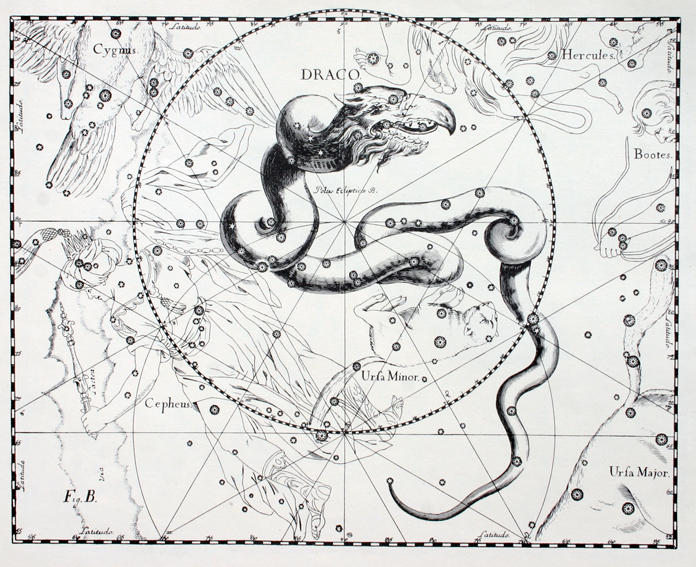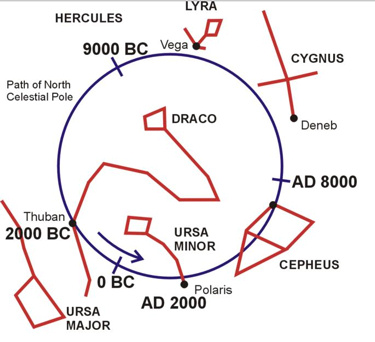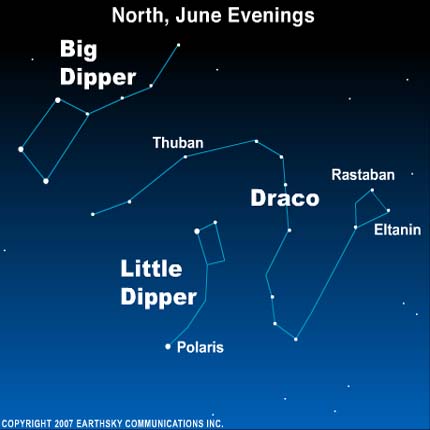
Thuban, pole star for ancient Egypt
Tonight, if you have a dark sky, you’ll be able to pick out the constellation Draco the Dragon winding around our modern-day pole star, aka the North Star, which we call Polaris. The image at the top of this post shows Draco as depicted in an old star atlas by Johannes Hevelius in 1690. See the circle? That circle indicates the changing position of the north celestial pole over a cycle of 26,000 years.
Thus the star we call Polaris was not always our north pole star. It was once an ordinary star in the northern sky, called Phoenice. A star in Draco, called Thuban, was the pole star when the Egyptian built the pyramids, some 5,000 years ago.
The 26,000-year cycle is called precession. It’s a slow, smooth wobbling that causes a change in the orientation of Earth’s axis over time. Precession causes Earth’s axis to trace out a circle among the stars. Thus, over time, Earth’s axis points to various stars, and the identity of our North Star changes.

The Dragon winds between the Big and Little Dippers
The Big Dipper can help guide you to Draco and its star Thuban. Just remember … the entire Dragon requires a dark sky to be seen. You’ll find the Big Dipper high in the north on June evenings. The two outer stars in the Dipper’s bowl point to our modern-day Polaris, the North Star, which marks the end of the Little Dipper’s handle.
The Little Dipper is relatively faint. If you can find both Dippers, then your sky is probably pretty dark. And you’ll need that dark sky to see Draco. You’ll have to let your eyes and imagination drift a bit to see the entire winding shape of the Dragon in the northern heavens.
See how the Draco winds between the Big and Little Dippers on the chart below?

Thuban is easy to find
Also – if you can find both Dippers, and if your sky is relatively dark – you can easily pick out Thuban. The star is easy to find by looking between the Dippers. Thuban is famous for having served as a pole star around 3000 B.C. This date coincides with the beginning of the building of the pyramids in Egypt. It’s said that the descending passage of the Great Pyramid of Khufu at Gizeh was built to point directly at Thuban. So our ancestors knew and celebrated this star.
Read more about Thuban, a former pole star

Bottom line: Let your eyes and imagination drift a bit to see the entire winding shape of Draco the Dragon in the northern sky. If you do spot it, be sure to pick out Thuban, a former pole star.
Read more: How to find the Big Dipper
Help EarthSky keep going! Please donate what you can.
The post The Dragon and a former pole star first appeared on EarthSky.
from EarthSky https://ift.tt/3z62O4s

Thuban, pole star for ancient Egypt
Tonight, if you have a dark sky, you’ll be able to pick out the constellation Draco the Dragon winding around our modern-day pole star, aka the North Star, which we call Polaris. The image at the top of this post shows Draco as depicted in an old star atlas by Johannes Hevelius in 1690. See the circle? That circle indicates the changing position of the north celestial pole over a cycle of 26,000 years.
Thus the star we call Polaris was not always our north pole star. It was once an ordinary star in the northern sky, called Phoenice. A star in Draco, called Thuban, was the pole star when the Egyptian built the pyramids, some 5,000 years ago.
The 26,000-year cycle is called precession. It’s a slow, smooth wobbling that causes a change in the orientation of Earth’s axis over time. Precession causes Earth’s axis to trace out a circle among the stars. Thus, over time, Earth’s axis points to various stars, and the identity of our North Star changes.

The Dragon winds between the Big and Little Dippers
The Big Dipper can help guide you to Draco and its star Thuban. Just remember … the entire Dragon requires a dark sky to be seen. You’ll find the Big Dipper high in the north on June evenings. The two outer stars in the Dipper’s bowl point to our modern-day Polaris, the North Star, which marks the end of the Little Dipper’s handle.
The Little Dipper is relatively faint. If you can find both Dippers, then your sky is probably pretty dark. And you’ll need that dark sky to see Draco. You’ll have to let your eyes and imagination drift a bit to see the entire winding shape of the Dragon in the northern heavens.
See how the Draco winds between the Big and Little Dippers on the chart below?

Thuban is easy to find
Also – if you can find both Dippers, and if your sky is relatively dark – you can easily pick out Thuban. The star is easy to find by looking between the Dippers. Thuban is famous for having served as a pole star around 3000 B.C. This date coincides with the beginning of the building of the pyramids in Egypt. It’s said that the descending passage of the Great Pyramid of Khufu at Gizeh was built to point directly at Thuban. So our ancestors knew and celebrated this star.
Read more about Thuban, a former pole star

Bottom line: Let your eyes and imagination drift a bit to see the entire winding shape of Draco the Dragon in the northern sky. If you do spot it, be sure to pick out Thuban, a former pole star.
Read more: How to find the Big Dipper
Help EarthSky keep going! Please donate what you can.
The post The Dragon and a former pole star first appeared on EarthSky.
from EarthSky https://ift.tt/3z62O4s

Aucun commentaire:
Enregistrer un commentaire